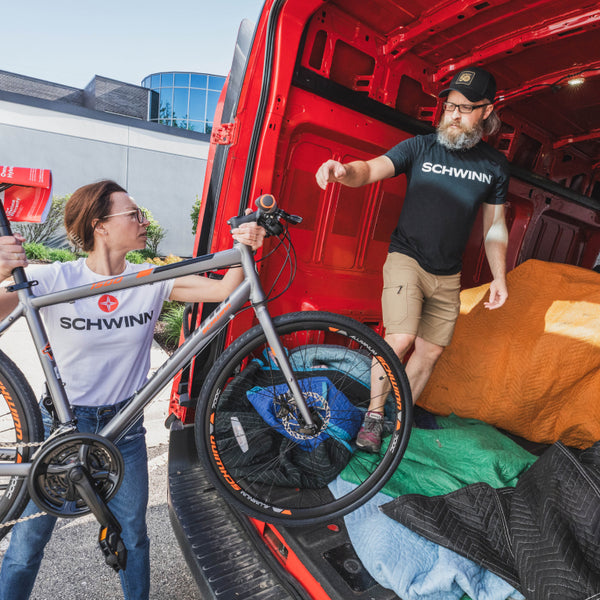You know the bikes, but do you know the man behind the name? Starting in the late nineteenth century, one man’s passion for bicycles would lead him to produce some of the most iconic designs and significant mechanical innovations in cycling. His name was Ignaz Schwinn.
Ignaz M. Schwinn was born in Hardheim, Germany on April 1st, 1860. The second of seven children, Ignaz was the son of a talented craftsman. His father, Frank Schwinn, was a master carpenter whose “masterpiece” was a pump organ that’s still playable to this day. (Both Richard Schwinn as well as his son have played that organ.) Sadly, Ignaz was only 11 years old when Frank died, but he was already following in his father’s footsteps by becoming a craftsman in his own right. Ignaz worked as an apprentice machinist before setting out to travel around Germany with a single goal in mind. He was determined to work on the latest technology craze that was sweeping the world: the bicycle.


Soon, Ignaz Schwinn began his apprenticeship in bicycles. At that time, High-Wheelers, also known as Ordinaries, were in vogue. Even though they were the latest and greatest design, they were still lacking in chain technology. Each pedal moved you exactly one wheel-rotation forward. By this logic, a larger wheel meant a larger rotation, and therefore a faster, more efficient ride. In reality, the enormous front wheel made it precarious, and often dangerous to ride.
While Schwinn may have spent much of his early twenties working with the Ordinary, he found himself drawn to the innovative new designs of James Starley. Starley was an English designer who had developed a model called the Safety bicycle. Safety bicycles reduced the size of the front wheel and added the modern concept of a chain connected to gears, creating something that bears a much stronger resemblance to the bicycles we see today. In his free time, Schwinn tinkered with the Safety bicycle, adding and improving upon the concept until he decided it was ready. Schwinn showed his designs to a man named Henrick Kleyer. Klever hired him and together they produced some of the very first Safety bicycles in Germany.
A year after he helped Kleyer build a new factory, Schwinn and Kleyer had a falling out, reportedly over a coaster brake design. This falling out was a key factor in why Ignaz and his wife, Helen (pictured below), left for America. Like the popularity of the bicycle, the population in Chicago was booming in 1891. Schwinn had found his niche. He started off working at a series of bicycle companies, but quickly became restless and needed more space for his creativity. A chance meeting in 1894 would soon change the course of Schwinn’s future.

Adolph Frederick William Arnold had started his career as the co-founder of Arnold Brothers’ meat market, in 1864. Since then, he had become a successful Chicago investor as well as the president of Haymarket Produce Bank. Eleven years Schwinn’s senior, Arnold knew a great opportunity when he saw it. With the sales and popularity of the bicycle industry continuing to rise, Arnold latched on.

Arnold Schwinn & Company was formed in 1895. Schwinn ran the business with Adolph Arnold as his financial backer. However, Schwinn had the good sense to give his backer top billing. With over 300 other manufacturers vying for consumer attention and the overwhelming supply keeping prices low, Schwinn needed to stay business savvy and relevant. In order to get retailers excited in their new company, Schwinn concocted the idea to hold a contest to create their new trade name. Four separate dealers submitted the name the "World". Schwinn liked the name’s strength, longevity, and prestige. He awarded the four winners $100 in cash for their efforts.

The world had gone crazy for bicycles. With bicycles finally designed in a manner that could safely be used by the general public, millions of Americans were buying and riding bicycles for their convenience, leisure, and freedom of movement. Bicycle races saw an increase in attendance - at one point, more people attended bicycle races than baseball games. Women found an increased sense of freedom that came with independent transportation, leading to new fashions in women’s clothing, and some say, increased confidence to further women's rights. More roads were being paved and whole clubs became devoted to cycling. People were enamored with the thrill and freedom that could be obtained with two wheels.

In 1899, Schwinn acquired the March Davis Bicycle Company and built a new factory. He avoided joining the American Bicycle Company, a collaboration that controlled 75% of the bicycle trade but went bankrupt by 1903. All of these decisions ultimately helped Schwinn and Arnold survive the impending ‘bicycle bust’.


In 1903, Henry Ford released the Ford Model A automobile. Two years later, it was apparent that adults had stopped cycling. Sales plummeted and only a dozen companies survived. With the demand for bicycles stagnating, Schwinn remained aggressive about building market share. He continued buying out small companies and by 1908, he bought out his partner, Arnold, as well.
In 1911, Schwinn bought Excelsior Motor Manufacturing & Supply Company. It was a timely purchase, as the motorcycle business exploded over the next 20 years. In 1912, Excelsior quickly gained renown after their Model X clocked in with a record speed of 100 mph. Schwinn seemed to find new joy in this venture. In 1914 he built what was then the largest motorcycle factory in the world and bought the popular, but unprofitable Henderson Brothers Motorcycle Company. Schwinn merged these two brands and created Excelsior-Henderson. This newly combined motorcycle brand soon became known for its excellent engineering and luxury looks, becoming one of the top 3 motorcycle companies behind Harley-Davidson and Indian.

It was the time spent in the motorcycle industry that would lead Schwinn to design some of the most loved bicycle models of the era. Bicycles with built-in tanks that hearkened to youthful imaginations inspired a new generation to ride.

During this period, Frank W. Schwinn, Ignaz’s son, joined the family business. Frank had served in World War I and had just completed a degree in engineering at the Illinois Institute of Technology. Upon joining his father, Frank W. worked primarily on the motorcycle side of the business.

Like the bicycle trend before it, the motorcycle boom began to decline in the 1920s. Then, with the stock market crash of 1929, Schwinn made the decision to close down the motorcycle business. He and Frank refocused their efforts on bicycles.
Then in 1931, at the age of 71, Schwinn started to transition towards retirement. Although he maintained the title of president of Arnold Schwinn & Company and was an important part of many decisions, he began to give Frank the reigns to the family business. Ignaz Schwinn died in 1948 at the age of 88 years old, leaving behind a legacy and a name that has become synonymous with the bicycle.

And the rest, as they say, is history.
A very special thanks to Richard Schwinn for all his contributions.














